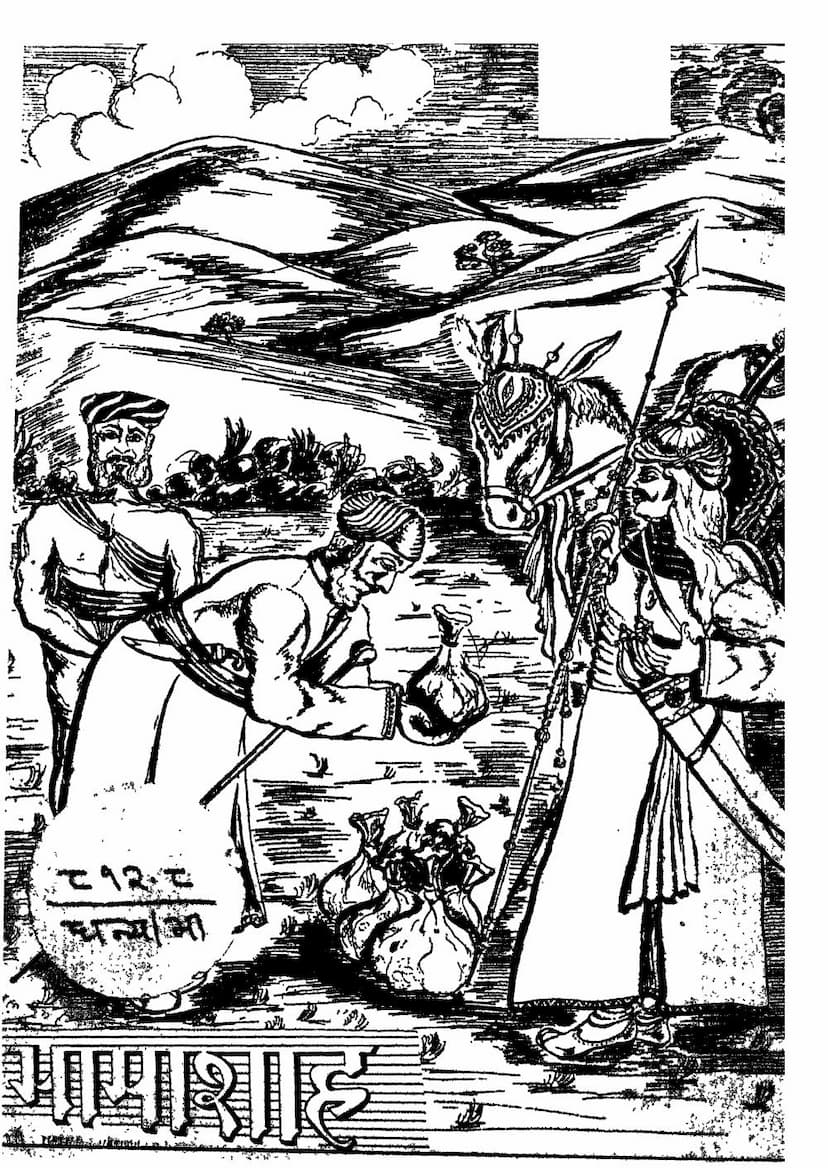Bhamashah
Added to library: September 1, 2025

Summary
Here's a comprehensive summary of the Jain text "Bhamashah" by Dhanyakumar Jain, based on the provided pages:
Book Title: Bhamashah (An Historical Drama) Author: Dhanyakumar Jain 'Sudhesh' Publisher: Jain Pustak Bhavan, Calcutta Publication Date: July 1956
Overall Theme and Purpose:
The drama "Bhamashah" by Dhanyakumar Jain 'Sudhesh' aims to highlight the life and contributions of Bhamashah, a historical figure renowned for his immense wealth and selfless sacrifice in supporting Maharana Pratap of Mewar. The book also seeks to address and clarify potential misconceptions about Jainism, particularly its principle of Ahimsa (non-violence), by showcasing Bhamashah, a devout Jain, actively participating in and supporting a war to protect his Dharma and homeland.
Key Aspects and Content:
-
The Central Figure: Bhamashah:
- Bhamashah is presented as a virtuous, wealthy, and supremely loyal minister to Maharana Pratap.
- His defining characteristic is his unparalleled generosity and selfless sacrifice, exemplified by his donation of his entire fortune to Maharana Pratap, enabling the Maharana to continue his fight against the Mughal Empire.
- The drama emphasizes that Bhamashah's actions were not driven by personal gain but by a deep commitment to his principles, his Dharma, and his king.
-
Reinterpreting Jain Ahimsa:
- A significant portion of the text, particularly in the "Manthan" (Churning) sections, delves into the philosophical underpinnings of Jain Ahimsa.
- The author argues that Jain Ahimsa is not passive cowardice but an "active Ahimsa" or "Ahimsa of the brave."
- It clarifies that violence undertaken for a noble purpose, such as the defense of Dharma, country, and the protection of innocents, is not considered Himsa (violence) in the Jain context, drawing upon the interpretations of Jain Acharyas like Somdev.
- Bhamashah's participation in aiding a war effort is thus presented as a demonstration of this active Ahimsa, where the intention behind the action is paramount.
-
Historical Context and Narrative:
- The drama is set against the backdrop of the struggles of Maharana Pratap against the formidable Mughal emperor Akbar.
- It portrays key events and figures of that era, including Maharana Udai Singh, Maharana Pratap Singh, Maharana Amar Singh, Man Singh, Mirsa Khan, and others.
- The narrative traces Bhamashah's lineage, his upbringing, and the auspicious circumstances surrounding his birth, which are attributed to divine blessings and the acquisition of a sacred conch.
- It highlights the strategic importance of battles like Haldighati and the critical role Bhamashah played in providing essential resources.
-
Characterizations:
- Bhamashah: Portrayed as a man of immense integrity, loyalty, foresight, and unwavering faith in Jain principles, even when faced with worldly temptations.
- Maharana Pratap: Depicted as a valiant warrior, deeply devoted to his land and Dharma, but also shown struggling with the hardships of war and the personal sacrifices involved.
- Taramchand (Bhamashah's brother): Also shown as a capable and loyal supporter, with an interest in arts and literature.
- Maharana Udai Singh: Shown as a ruler who, despite his flaws and susceptibility to sensual pleasures (represented by Veera), recognizes Bhamashah's family's loyalty and appoints them to key positions.
- Amarsingh (Maharana Pratap's son): Depicted as less virtuous and more inclined to worldly pleasures, leading to tragic events, particularly concerning Tarachand's family, highlighting the contrast with his father's and uncle's character.
- Veera: Represents the corrupting influence of worldly desires on rulers.
- Other characters: Various historical figures and supporting characters are presented to flesh out the historical narrative and support the central themes.
-
Key Events and Plot Points:
- The prophecy of Bhamashah's birth and his family's prosperity linked to a sacred conch.
- Bhamashah's appointment as minister under Maharana Udai Singh and later Maharana Pratap.
- The personal crisis of Maharana Pratap where Bhamashah offers his entire wealth.
- The events surrounding Man Singh's visit, his insult, and the subsequent preparations for war.
- The tragic fate of Tarachand's family due to Amar Singh's lustful actions.
- Bhamashah's unwavering loyalty even after personal tragedy.
- The profound impact of Bhamashah's sacrifice on the morale and continued resistance of Maharana Pratap.
- Discussions about the nature of Jain Ahimsa, its application in defense of righteousness, and historical precedents for Jain participation in warfare.
- The book also includes the family tree and list of characters, along with a bibliography of supporting historical texts.
Literary Style and Presentation:
- The drama is written in Hindi, employing a formal and respectful tone, befitting historical and religious themes.
- The "Manthan" sections serve as critical analyses and historical justifications for the events and interpretations presented in the drama.
- The inclusion of several commendatory messages from prominent literary and political figures of the time (e.g., Dr. Kalidas Nag, Ganeshprasadji Varni, Mishrilal Gangwal, Yashpal Jain) highlights the book's perceived significance.
- The play is structured into Acts and Scenes, detailing dialogues and stage directions.
Overall Significance:
"Bhamashah" is presented as a significant contribution to Jain literature and Indian historical drama. It aims to immortalize the legacy of Bhamashah, showcase the practical application of Jain ethical principles in challenging times, and foster patriotism and a sense of duty among its readers. The book serves as an inspiration, urging readers to learn from Bhamashah's example of selfless service and sacrifice for a greater cause.